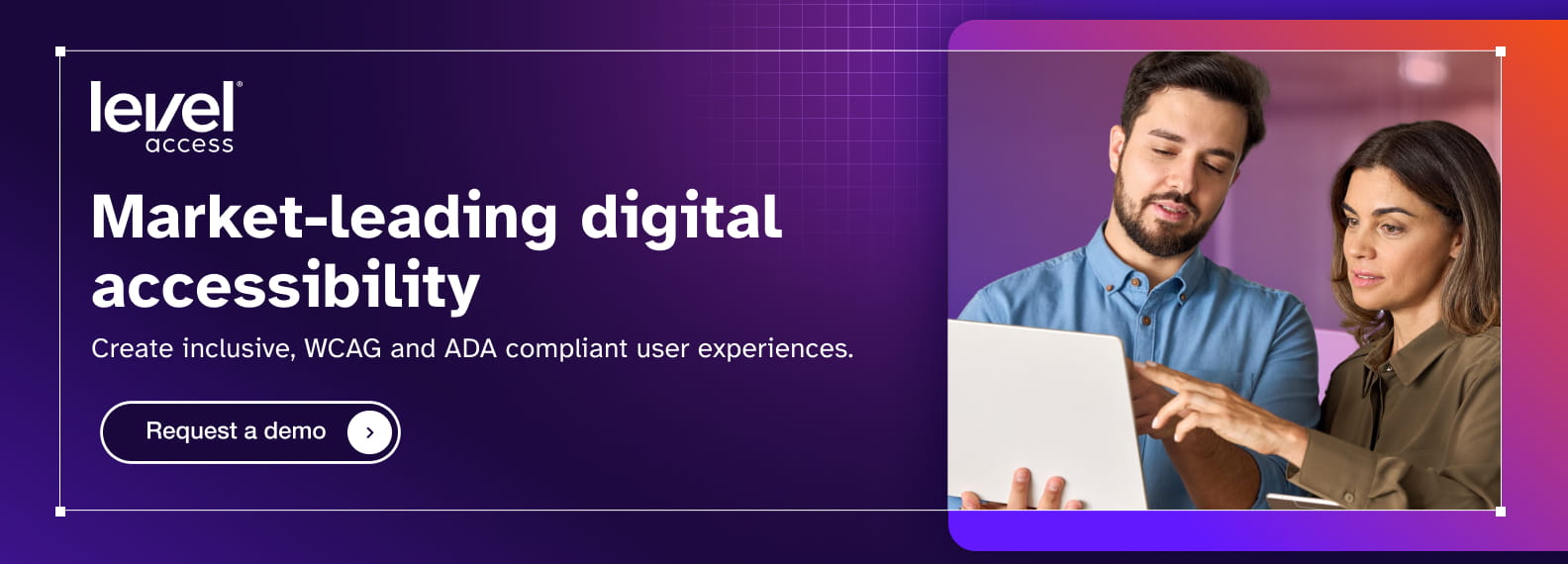Many organizations perceive digital accessibility as a binary concept—either content is accessible to people with disabilities, or it’s not. This simplistic pass-or-fail viewpoint, driven by standards like WCAG and regulatory mandates, overlooks the dynamic nature of accessibility. Consequently, businesses may miss opportunities to recognize, demonstrate, and celebrate their continuous progress toward greater inclusivity. This is where obtaining an accessibility score for digital properties becomes invaluable.
In this blog, we’ll explore how accessibility scoring enables organizations to monitor the progress of website and app performance, prioritize improvements, and illustrate their ongoing commitment to inclusivity in ways that a simple pass / fail system cannot.
What is accessibility scoring?
Accessibility scoring is a method for evaluating how well an organization’s digital assets—such as websites, applications, and online services—meet accessibility standards and provide inclusive experiences for all users. More than just a measurement, it serves as a powerful business metric.
Accessibility scoring assigns a numerical or categorical value that reflects the extent of an organization’s compliance and progress toward accessibility goals.
This scoring system typically considers various factors, including conformance to the Web Content Accessibility Guidelines (WCAG), compliance with accessibility laws, and the overall usability of digital properties for people with disabilities. By breaking down accessibility into measurable components, organizations can:
- Track improvements over time: Regularly monitor scores to understand how accessibility is evolving across different digital properties.
- Identify strengths and weaknesses: Pinpoint specific areas that need attention, allowing teams to prioritize improvements.
- Measure up to industry standards: By comparing their accessibility scores with industry averages or those of competitors, organizations can assess their market position and set informed, achievable goals.
- Demonstrate commitment: Accessibility scores provide tangible evidence of an organization’s commitment to accessibility, which can support funding requests and build trust with stakeholders and customers. And with 60% of businesses planning to maintain or increase their dedicated digital accessibility budget in the year ahead, web accessibility scoring is essential for showcasing progress and ensuring continued investment.
Whether you’re evaluating a single website or an entire digital portfolio, accessibility scoring ensures you’re moving forward with data-driven clarity. Continuously evaluating digital assets against established accessibility criteria helps turn accessibility from a one-time compliance requirement into an ongoing practice. But what exactly are these accessibility criteria? Let’s explore some key laws and guidelines that inform accessibility scoring.
Understanding the criteria for web accessibility scores
Standards and guidelines are the cornerstone of accessibility criteria. The Web Content Accessibility Guidelines (WCAG) is a widely recognized technical standard developed as part of the W3C Web Accessibility Initiative (WAI). These guidelines are structured around four key principles: Perceivable, Operable, Understandable, and Robust (POUR).
WCAG establishes a minimum baseline for digital accessibility and is typically assessed on a pass / fail basis, depending on whether specific success criteria under the four POUR principles have been satisfied.
Legal regulations are also a critical factor in accessibility criteria. Some examples of accessibility legislation include the Americans with Disabilities Act (ADA), the Accessibility for Ontarians with Disabilities Act (AODA) and the European Accessibility Act (EAA).
Among these regulations, France’s Montchamp Law stands out because its standard for compliance – the RGAA – specifically incorporates accessibility scoring. Additionally, the upcoming WCAG version 3.0 aims to incorporate accessibility scoring mechanisms, highlighting a growing acknowledgment of the necessity for measuring accessibility progress.
How are accessibility scores calculated?
Accessibility scores are calculated by evaluating digital assets against established accessibility criteria and standards. This process typically involves a combination of web accessibility testing tools, including automation, manual testing, and user feedback to provide a comprehensive assessment. Here’s a breakdown of how the accessibility of an organization’s digital properties can be calculated:
1. Automated monitoring
Accessibility scores can be tracked through automated tools that crawl websites or simulate user flows. These tools continuously test web pages to assess their accessibility, providing an up-to-date snapshot of the current state of your digital properties. This automated approach ensures that scores reflect real-time conditions and any ongoing changes to your site.
2. Manual audits
While automated testing offers efficiency, manual evaluations (also called audits) provide a more detailed and accurate picture of an experience’s accessibility. Audits can validate fixes, uncover hidden issues, and provide a more reliable assessment of compliance than automated tools. The findings from these audits can inform your accessibility score. It’s recommended to obtain manual audits one to two times a year, or after major web updates, to ensure your score reflects the most current state of your digital presence.
3. User testing
Ultimately, the most important metric for accessibility is whether users with disabilities want to use your product. In user testing, also called use case testing, testers with disabilities and native assistive technology (AT) users aim to complete specific tasks in a digital experience and identify barriers for AT. This type of testing is essential for ensuring digital assets are genuinely user-friendly.
By integrating these methods into team processes, organizations can make rating accessibility an agile and achievable practice.
Level Access helps you keep score on accessibility
Partnering with an experienced third-party digital accessibility provider, like Level Access, can equip you with the tooling, legal guidance and usability testing required to meet your accessibility goals. Our solution provides everything you need to monitor, manage, and improve the usability across all your digital properties for measurable, actionable and transparent progress. Engage with a member of our team to get started.
The post The Value of Accessibility Scoring appeared first on Level Access.
